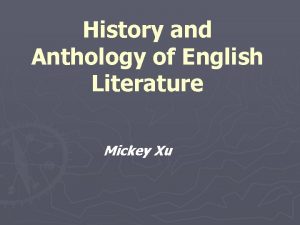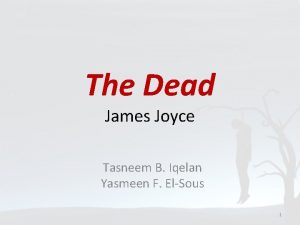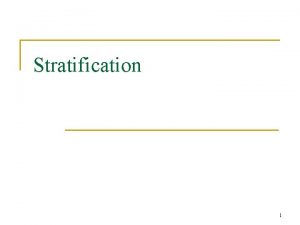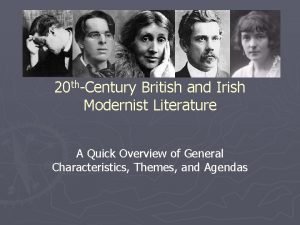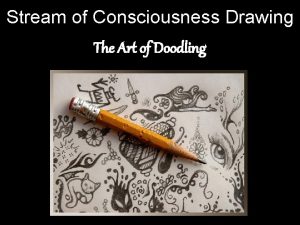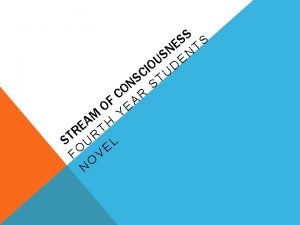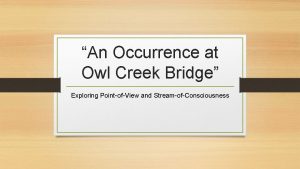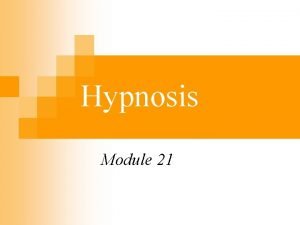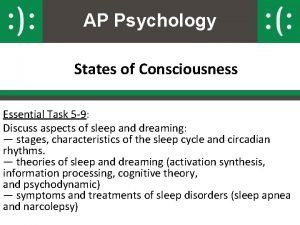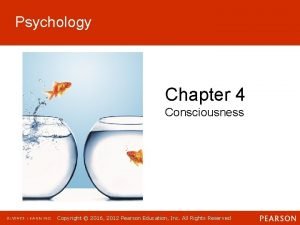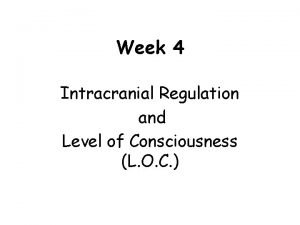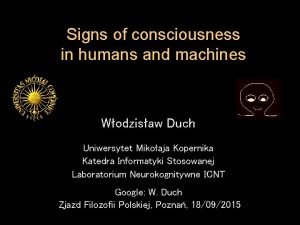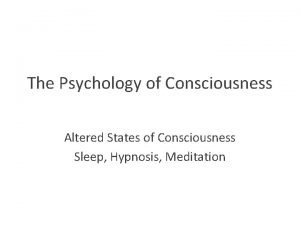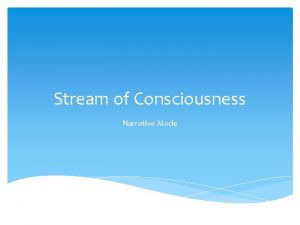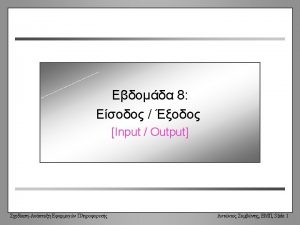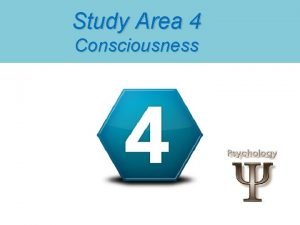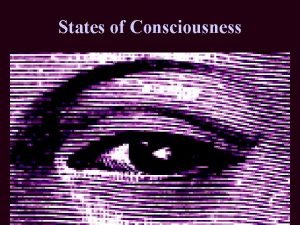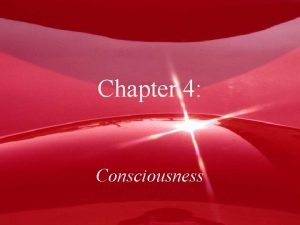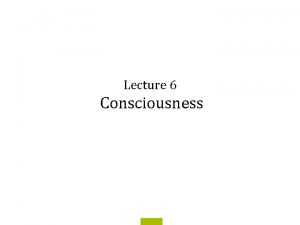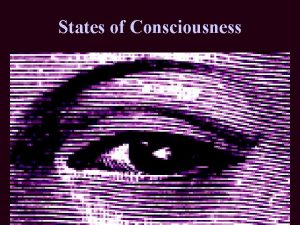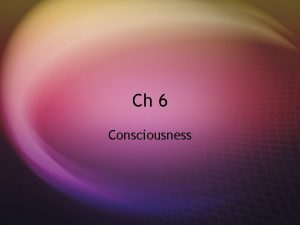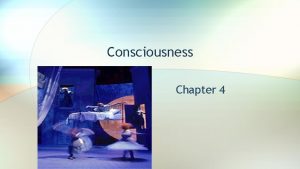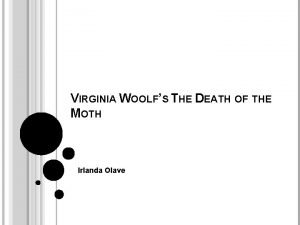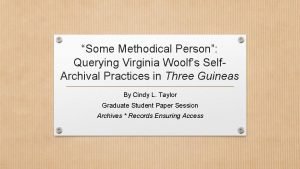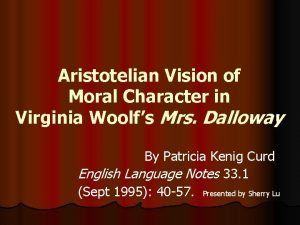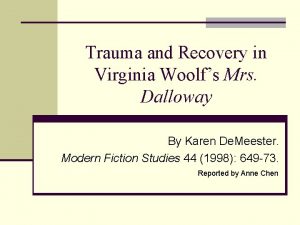Virginia Woolfs Stream of Consciousness technique with special


















- Slides: 18

Virginia Woolf’s Stream of Consciousness technique, with special reference to her To The Lighthouse and Mrs. Dalloway � Introduction � The Stream of Consciousness novel/ The psychological novel/ The novel of subjectivity � Virginia Woolf � The characteristics of the Stream of Consciousness novel: probing into the human consciousness, increased inwardness, decay of character and decay of plot


Probing into the human consciousness and increased inwardness � To The Lighthouse Meaninglessness of life: Mr. Ramsay’s desire “to be taken within the circle of life, warmed and soothed” for he feels “barren, ” “bare” and an utter “failure. ” “the creaking hinges, ” “the screeching of bolts” and “the banging of damp swollen woodwork” bespeaks the stillness surrounding the house. Nostalgia: “clothes in the cupboards, ” “boots, ” “shoes” and the “brush and comb left on the dressing-table” are best interpreted as an elegy that laments the tragedy that has overtaken the Ramsays, stirring deep feelings of nostalgia. � Mrs. Dalloway Meaninglessness of life: Mrs. Dalloway often questions life’s true meaning, wondering whether happiness is truly possible. She feels both a great joy and a great dread about her life. “it might be possible that the world itself is without meaning. ” Nostalgia: Mrs. Dalloway's mind moves on to memories from her childhood, then back to the taxi cabs in the street, and finally to Peter, a former romantic interest. Clarissa’s party stirs up memories for many of the characters, and memories are constantly woven into the present-day thoughts of the characters.







Decay of character � To The Lighthouse Indirect delineation of characters: James’ hostility is unfolded through his stream of consciousness, thinking “Had there been[…]any weapon that would have gashed a hole in his father’s breast and killed him’’ “there is no plot, no character, no tragedy, no comedy and no love interest as was in the traditional novel. ” Internal conflict: There is a conflict within Mr. Ramsay himself who “wanted something – wanted the thing [Mrs. Ramsay] always found it so difficult to give him; wanted her to tell him that she loved him” � Mrs. Dalloway Indirect delineation of characters: Woolf moves deeply into Septimus’ mind intensifying his feelings of sadness when he decides to kill himself. In the form of an indirect speech, Woolf explains that “ he would not kill himself. And it was cowardly for a man to say he would kill himself, but Septimus had fought; he was brave; he was not Septimus now. ” Internal conflict: Clarissa elaborates: “For in marriage a little licence, a little independence there must be between people living together day in day out in the same house; which Richard gave her, and she him (where was he this morning, for instance? Some committee, she never asked what. ) But with Peter everything had to be shared, everything gone into”





Decay of plot � To The Lighthouse No chronological order: The novel moves freely backward and forward in time, instead of telling a story with an eye on the calendar. Concerning time in relation to the plot in To the Lighthouse, it is of a great concern to Woolf that she follows its significance to Mrs. Ramsay as the “fall of the waves on the beach…. Warned her whose day had slipped past in one quick doing after another that it was all ephemeral as a rainbow. ” Fragmentation: Lily's thoughts in part three bounce around from the lighthouse to Mr. Ramsay to escape, then back ten years ago, to a picture, to wondering where her paints got to. All of these ideas come up in her mind in the same moment reflect the incompleteness of thought and life. � Mrs. Dalloway No chronological order: Instead of the continuity of action by which the traditional novel is known, the Modern Novel has a tendency to discontinuity. Mrs. Dalloway covers one day from morning to night in one woman’s life. Clarissa relates to the gravity and power of time, pondering: “For having lived in Westminster-how many years now? over twenty, - one feels… an indescribable pause; a suspense… before Big Ben strikes. There! Out it boomed. First a warning, musical; then the hour, irrevocable. ” Fragmentation: The past of the characters significantly contributes to the plot, suggesting a sense of fragmentation. Virginia Woolf eloquently uses methods of suspense, mainly fragmentation, to convey her views of the human scene, dealing with all facts in contemporary life; pleasant and unpleasant, beautiful and ugly.



Conclusion � In both novels, Woolf rebels against the techniques of the previous novels, dealing with a variety of themes and subject matters. � Woolf’s Modern novels realistically present the doubts, conflicts and frustrations of the Modern world, revealing her philosophy of life that each individual is a lonely soul. � Woolf’s psychological novels serve as a mirror that reflects the Modern Age’s gradual weakening of faith in the aftermath of WWI, the shift from the extrovert to the introvert and the search for new values and systems.
 Stream of consciousness technique
Stream of consciousness technique Mickey xu
Mickey xu Virginia woolf performer heritage
Virginia woolf performer heritage Molly ivors
Molly ivors Types of mobility
Types of mobility Stream of consciousness literature
Stream of consciousness literature Stream of consciousness drawing
Stream of consciousness drawing Stream of consciousness narration definition
Stream of consciousness narration definition Eveline symbolism
Eveline symbolism An occurrence at owl creek bridge stream of consciousness
An occurrence at owl creek bridge stream of consciousness Differentiate byte stream and character stream
Differentiate byte stream and character stream Seo northern virginia virginia
Seo northern virginia virginia Special needs trust virginia
Special needs trust virginia What is the social influence theory of hypnosis
What is the social influence theory of hypnosis Sleep theories ap psychology
Sleep theories ap psychology Psychology chapter 4 consciousness
Psychology chapter 4 consciousness Level of consciousness
Level of consciousness Signs of consciousness
Signs of consciousness Altered state of consciousness psychology
Altered state of consciousness psychology

